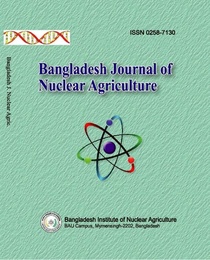YIELD PERFORMANCE OF BINA DEVELOPED LENTIL VARIETIES
Abstract
The field experiment was conducted at research farm of BINA sub-station Ishurdi during the winter (rabi) season, 2016-2017 to find out the best yield performance of BINA developed lentil varieties that are able to increase lentil production in Bangladesh within short maturity period. BINA developed nine lentil varieties (Binamasur-1, Binamasur-2, Binamasur-3, Binamasur-4, Binamasur-5, Binamasur-6, Binamasur-7, Binamasur-8 and Binamasur-9) were tested in Randomized Complete Block Design (RCBD) with three replications to evaluate their morphological and yield contributing characters. The performance of Binamasur-8 is the best for maximizing seed yield with short maturity period. Binamasur-8 produced 2.37 t ha-1 yields with 88 maturity days. Primary branch production is more important than plant height in achieving higher seed yield in lentil. More primary branches ensure more pod number which also increase seed number and finally produce more seed yield. Seed size was also responsible for high yield achievement. Among all the BINA developed lentil varieties Binamasur-8 was found pioneer followed by Binamasur-5 in respect of seed yield with earliest maturity period. Therefore, it will be possible to increase lentil production in Bangladesh by cultivating Binamasur-8.
References
Anzam, M.S., Ali, A., Iqbal, S.M. and Haqqani, A.M. 2005. Evaluation and correlation of economically important traits in exotic germplasm of lentil. Int. J. Agric. Biol., 7: 959-961.
Anonymous. 2012. Fertilizer Recommendation Guide 2012. Bangladesh Agricultural Research Council (BARC). Farmgate, Dhaka. p. 98.
Anonymous. 2013. Grain Composition. Lupin Food Australia. Perth: Australia.
BBS (Bangladesh Bureau of Statistics). 2019. Yearbook of Agricultural Statistics of Bangladesh. Reproduction, Documentation and Publication Wing, BBS, Secretariat, Dhaka.
Kakde, S.S., Sharma, R.N., Khilkre, A.S. and Lambade, B.M. 2005. Correlation and path analysis studies in lentil. J. Soil Crops. 15: 67-71.
Karadavut, U. 2009. Path analysis for yield and yieldcomponents in lentil.Turkish J. Field Crops. 14: 97-104.
Khatun, S. and Kim, T. 2021. Phenolic compound, antioxidant activity and nutitional components of five legume seed. Am J Biomed Sci & Res. 12(4). 328-334. doi: 10.34297/AJBSR.2021.12.00
Khatun, S., Mondal, M.M.A., Khalil, M.I., Mollah, M.M.I. and Kamruzzaman, M., 2016. Impact of Morpho-Physiological Traits on Seed Yield of Lentil (Lens culinaris Medik). International J. Agric. Innov. Res. 5(1): 2319-1473.
Kouris-Blazos, A., Belski, R., 2016. Health benefits of legumes and pulses with a focus on Australian sweet lupins. As. Pac. J. Clin. Nutr. 21: 1-17.
Mondal, M.M.A., Puteh, A.B., Malek, M.A., Roy, S. and Rafii. 2013a. Contribution of morpho-physiological traits on yield of lentil (Lens culinaris Medik). Australian J. Crop Sci., 8: 1167- 1172.
Mondal, M.M.A., Puteh, A.B., Malek, M.A. and Kabir, A.K.M.R. 2013b. Flowering pattern and reproductive efficiency in lentil. Legume Res. 36 (2): 153-157.
Popelka, J.C., Terryn, N. and Higgins, T.J.V. 2004. Gene technology for grain legumes: can it contribute to the food challenge in developing countries? Plant Sci. 167: 195-206. doi: 10.1016/j.plantsci.2004.03.027.
Rahman, M.A. and Ali, M.O. 2011. The causes of decrement in pulse production and its possible remedy. Proceedings of the International Conference on ‘Pulses in South Asia’ held at the Bangladesh Agricultural Research Institute, Gazipur-1701, Bangladesh. 17-19 February 2011. pp. 91-94.
Rasheed, M., Jilani, G., Shah, I.A., Najeeb, U. and Iqbal, T. 2010. Genotypic variants of lentil exhibit differential response to phosphorus fertilization for physiological and yield attributes. Acta Agriculture Scandania., Section-B: Soil Plant Sci. 60: 485-493.
SAIC. 2018. Annual report of SAARC Agricultural Information Centre (SAIC), Farmgate, Dhaka-1215.
SAS Institute Inc., 2018. SAS/STAT user’s guide, Release 6.03, Ed. Cary, NC.
Staniak, M., Księżak, J., Bojarszczuk, J. 2014. Mixtures of legumes with cereals as a source of feed for animals. In: Pilipavicius V, editor. Organic Agriculture Towards Sustainability. In Tech: Croatia. pp. 123-145.
Yadav, S.S., Phogat, D.S., Solanki, I.S. and Tomer, T.S. 2003. Character association and path analysis in lentil. Indian J. Pulse Res. 16: 22-24.
Yorgancilar, M. and Bilgicli, N., 2014. Chemical and nutritional changes in bitter and sweet lupin seeds (Lupinusalbus L.) during bulgur production. J. Food Sci. Technol. 51: 1384-1389.
-
Download



